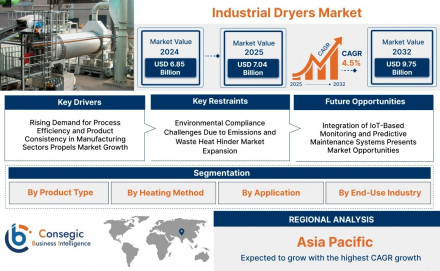Industrial Dryers Market Trends and Competitive Landscape (2025-2032)

Industrial Dryers Market Size:
Industrial Dryers Market size is estimated to reach over USD 9.75 Billion by 2032 from a value of USD 6.85 Billion in 2024 and is projected to grow by USD 7.04 Billion in 2025, growing at a CAGR of 4.5% from 2025 to 2032.
Industrial Dryers Market Introduction:
Industrial dryers are mechanical devices used to reduce moisture levels in bulk materials, essential in various manufacturing processes across industries such as food, pharmaceuticals, chemicals, minerals, paper, and textiles. These systems work by applying heat to evaporate moisture and use air or other gases to remove the resulting vapor. Industrial dryers come in various forms, including rotary dryers, fluidized bed dryers, spray dryers, and vacuum dryers, tailored to specific material characteristics and process requirements. With increasing demand for high-performance and energy-efficient drying technologies, industrial dryers play a crucial role in ensuring product quality and operational efficiency.
Industrial Dryers Market Overview:
The global Industrial Dryers Market is witnessing steady growth due to its indispensable application in process industries. In 2024, the market was valued at approximately USD XX billion, and it is projected to grow at a CAGR of X.X% during the forecast period 2025–2032. Factors driving this growth include increasing demand for processed food, expansion of pharmaceutical production, and advancements in drying technologies. Additionally, sustainability concerns and energy efficiency requirements are pushing companies to invest in innovative drying solutions with lower energy consumption and emissions
Industrial Dryers Market Includes Drivers, Restraints & Opportunities
Drivers:
- Rising demand from the food and beverage industry: The need for preserving food products and extending shelf life has spurred the use of dryers in dehydration and drying processes.
- Growth in pharmaceutical and chemical industries: Strict moisture control is essential in these sectors for product stability and quality.
- Technological advancements: Introduction of smart dryers equipped with IoT sensors, AI-based control systems, and automation is increasing productivity and reducing operational costs.
- Focus on energy efficiency: Regulatory pressures and the high cost of energy are leading industries to adopt more efficient dryers to minimize waste and energy usage.
Restraints:
- High initial investment: Advanced drying systems, especially those with automation or vacuum features, entail high capital costs, which can deter small and medium enterprises (SMEs).
- Operational and maintenance complexity: Some dryers require specialized knowledge for operation and maintenance, adding to overall costs.
- Environmental regulations: Emission norms and waste management laws related to exhaust gases or heat may limit the deployment of older drying technologies.
Opportunities:
- Adoption in emerging economies: Rapid industrialization and infrastructure development in Asia-Pacific, Latin America, and Africa open up significant market opportunities.
- Customization and modular dryers: The demand for tailor-made drying systems for specific industries is growing, encouraging innovation.
- Integration with renewable energy: Using solar and biomass energy to power dryers is a growing trend, especially in rural and agro-industrial applications.
- Expansion of pharmaceutical and biotech sectors: Post-COVID-19 focus on health and hygiene has led to increased pharmaceutical manufacturing, boosting the need for controlled drying solutions.
Industrial Dryers Market Competitive Landscape Analysis (Key Players)
- ThyssenKrupp AG (Germany)
- Andritz AG (Austria)
- COMESSA (France)
- Mitchell Dryers Ltd. (United Kingdom)
- Yamato Sanko Mfg. Co., Ltd. (Japan)
- GEA Group (Germany)
- Metso Corporation (Finland)
- FLSmidth & Co. A/S (Denmark)
- Bühler Holding AG (Switzerland)
- ANIVI Ingeniería SA (Spain)
Industrial Dryers Market Industry Segmentation:
By Product Type
- Rotary Dryers
- Fluidized Bed Dryers
- Spray Dryers
- Flash Dryers
- Drum Dryers
- Freeze Dryers
- Others
By Heating Method
- Direct Heating
- Indirect Heating
- Hybrid Heating
By Application
- Granulation
- Moisture Removal
- Solvent Recovery
- Product Preservation
- Others
By End-Use Industry
- Food & Beverage
- Pharmaceuticals
- Chemicals
- Fertilizers
- Cement
- Textiles
- Others
By Region
- Asia-Pacific
- Europe
- North America
- Latin America
- Middle East & Africa
Regional Analysis of the Industrial Dryers Market:
- North America: Dominated by strong presence of pharmaceutical and chemical industries, along with technological innovation.
- Europe: Growth driven by stringent energy-efficiency regulations and high demand for processed food.
- Asia-Pacific: Fastest-growing region due to rapid industrialization, rising demand in the food and chemicals sectors, and increasing investments in manufacturing.
- Latin America: Growing adoption in the agriculture and mining sectors is driving demand.
- Middle East & Africa: Infrastructure development and industrial diversification in countries like UAE and South Africa are contributing to market growth.
Industrial Dryers Market Recent Developments:
- January 2024: GEA Group launched a new series of energy-efficient spray dryers integrated with AI-driven process control to optimize drying time and reduce emissions.
- October 2023: SPX FLOW expanded its footprint in Asia-Pacific by opening a new R&D center in Singapore focused on heat transfer and drying technologies.
- August 2023: ANDRITZ AG introduced a hybrid solar-electric fluid bed dryer for sustainable operations in the agro-industrial sector.
- May 2023: Bühler AG partnered with a biotech firm to develop custom dryers for enzyme and protein processing.
- March 2023: FLSmidth developed an advanced rotary dryer with 15% lower energy consumption for the cement industry.
Contact us:
Consegic Business intelligence Pvt Ltd.
Contact no: (US) (505) 715-4344
Email: sales@consegicbusinessintelligence.com

